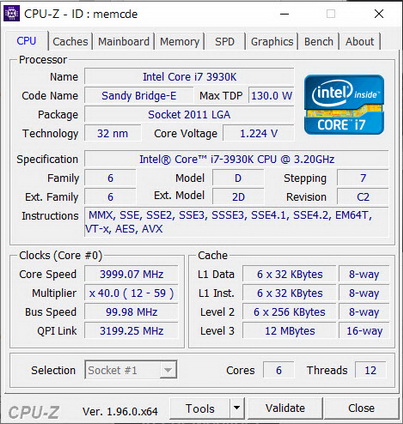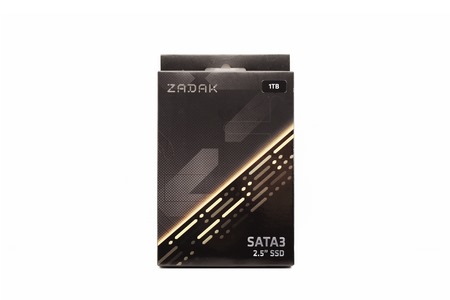INTRODUCTION

M.2 NVMe SSDs may currently be the go to primary drive for a large segment of the consumer market but when it comes to secondary drives SATA III SSDs are clear in the lead. Of course, the SATA III (6Gb/s - 600MB/s) standard has been maxed out for years now but since there's still a considerable market for it (compatibility with older systems - both desktops and laptops - alone is more than enough) manufacturers are still dishing out models with capacities ranging all the way up to 8TB (alas under the radar compared to M.2 NVMe drives). The TWSS3 2.5" SATA III SSD by ZADAK is one such drive and that's what today's review is all about.
ZADAK is a high-end custom water-cooled PC brand founded by a group of people of designers, modders, and engineers in the autumn of 2015. Original design, craftsmanship, and beyond the boundary are the core values of ZADAK. We want to create a custom water-cooled computer & case which is sophisticated and elegant, just like an artwork, an enjoyment. We also want to create something that is easy for you to assemble your own fantasy PC. After years of development, tons of experiments and prototypes, ZADAK finally settles on a design that would be the key of why we are able to make the water-cooled computer so compact. ZADAK hopes that you will get as much fun out of building your own fantasy PC as we do.
The TWSS3 line of 2.5" SATA III SSDs by ZADAK is currently available in 128/256GB/512GB/1TB/2TB capacities and much like several similar models it's based on the DRAM-less SM2258XT quad-channel NAND flash controller by Silicon Motion paired with 3D TLC NAND flash by Sandisk (according to ZADAK this combination allows the TWSS3 to reach performance numbers of up to 560MB/s in read and 540MB/s in write). A DRAM-less controller like the Silicon Motion SM2258XT may be far from the fastest one out there but still it does feature several technologies such as static data refresh (ensures data integrity), error-correction, global wear-levelling, S.M.A.R.T, TRIM, NCQ, thermal-throttling, active garbage collection, DevSleep (device sleep - power saving feature) and SLC write caching (algorithms for optimal sustained performance). Last but not least ZADAK covers the entire TWSS3 line of 2.5" SATA III SSDs with a 5-year limited warranty (if you hit the advertised TBW first that's what applies in terms of warranty) and reports write endurance numbers of 75TBW for the 128GB model, 180TBW for the 256GB model, 320TBW for the 512GB model and 600TBW for the 1TB model (TBW for the 2TB model is not yet available - all models feature an MTBF of 1.5 million hours).
SPECIFICATIONS AND FEATURES

THE TWSS3 1TB
ZADAK uses a small box that just has their logo and the drive connectivity, form factor and capacity at the front.
A quick product description is placed at the rear in 16 languages right over the product barcodes and contact information for ZADAK.
The TWSS3 follows the typical 2.5" factor and features a black sticker at the top.
Another sticker is located at the belly of the drive and contains its serial numbers, capacity and barcodes.
At the rear of the drive, we find the usual SATA III power and data connectors.
Opening the enclosure is very easy and as you can all see the PCB actually takes up less than half of the interior.


 The TWSS3 1TB is a single side drive and so here we see the SM2258XT DRAMless NAND flash controller along with two 3D TLC NAND flash modules by Sandisk (512GB in capacity each).
The TWSS3 1TB is a single side drive and so here we see the SM2258XT DRAMless NAND flash controller along with two 3D TLC NAND flash modules by Sandisk (512GB in capacity each).
ZADAK WIDGET
If you want to be able to monitor the status of your drive and/or quickly test its performance you can download the Widget from the ZADAK support page.
TEST BED


TESTING METHODOLOGY
After over 12 years of testing solid state drives, I’ve concluded that it's almost impossible for any single benchmark suite to accurately measure their performance and that's why in certain benchmark suites we see amazing read/write performance numbers with some drives while in others things are quite different. The reason behind this is that some benchmarking suites are configured to read and write random chunks of data while others read and write constant (sequential) ones. So that's why i always use a very wide selection of benchmarking suites including AIDA64, HD Tach RW, HD Tune Pro, Crystal Disk Mark, Sisoftware Sandra Pro, AS SSD, IOmeter and ATTO. To get the most accurate results each test gets repeated a total of 6 times with the average performance numbers recorded into our charts*. Also, as of February 25th 2015 our results will also include the Storage Networking Industry Association’s (SNIA) IOMeter tests. These tests include a 12 Hour write test used to “simulate” performance degradation over time and a mixed workload test which basically shows what you can expect when using an SSD continuously for roughly two hours. Unfortunately, due to the time required for these tests we repeat them a total of 3 times and not 6 as the above.
Many people have made inquiries about the charts in the past so once again please do keep in mind that the Charts have the average performance numbers of each drive recorded and not the peak (highest) ones. Also, although every single one of these programs can help potential buyers choose the right drive for their needs you should also remember that from any kind of benchmark up to real world usage the gap is not small (and usually most differences will go unnoticed by most people). All tests were performed in a fresh Windows 10 Pro x64 installation with every update installed up to the date of this review.
* Since November 2018 the SSD comparison charts have been divided to 2.5” and M.2 models to reduce their growing size.
TEST RESULTS - AIDA64 / ATTO


TEST RESULTS - HD TACH RW / HD TUNE PRO


TEST RESULTS - SISOFTWARE SANDRA PRO / CRYSTAL DISK MARK


TEST RESULTS - AS SSD / IOMETER


TEST RESULTS - IOMETER SNIA

CONCLUSION

The ZADAK TWSS3 1TB performed exactly as I was expecting, meaning just like with most 2.5” SSDs out in the market today (in some tests better and in some worse). This of course is not a bad thing, the SATA III connectivity has been maxed out for well over 5 years now so we can’t expect anything new in terms of performance to appear in the market (although 550MB/s+ sustained models would be nice). So aside performance the only things which are basically left are endurance and capacity and even though the TWSS3 does well on the former it falls back on the latter. Yes, the highest capacity model (2TB) should be more than enough for most consumers out there but several brands already have 4TB models available (less than a handful have 8TB ones) so ZADAK should expand their available capacities (either with this or other models).
Just like with the SPARK RAM kit again by ZADAK I was unable to find the 1TB TWSS3 2.5” SSD anywhere online so once again i find myself unable to comment about price (and thus a price/performance ratio). Still based on its performance numbers if you can get your hands on a ZADAK TWSS3 1TB 2.5” SSD for the same price as one of the other DRAMless models you should really consider doing so.
PROS
- Overall Performance
- NAND Controller Features
- Endurance Numbers (600TBW For The 1TB Capacity)
- 5 Year Limited Warranty
- Price
CONS
- Current Availability
- Value Model (DRAMless Design)
- No Cloning Software Included
- Available Capacities (Only Up To 2TB)

 O-Sense
O-Sense


















.png)

